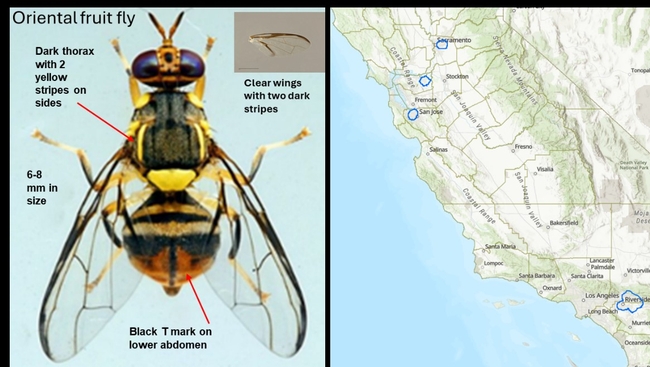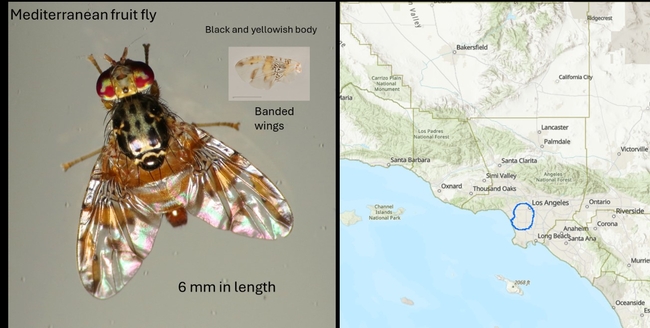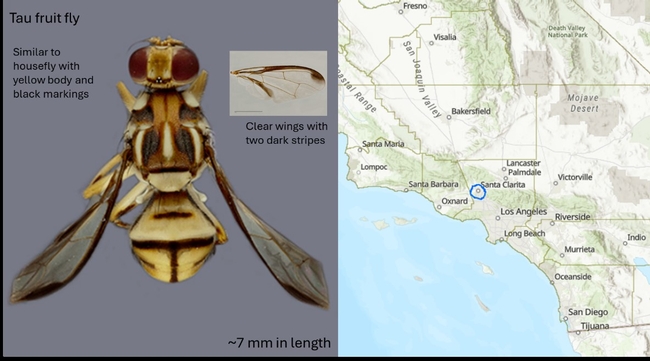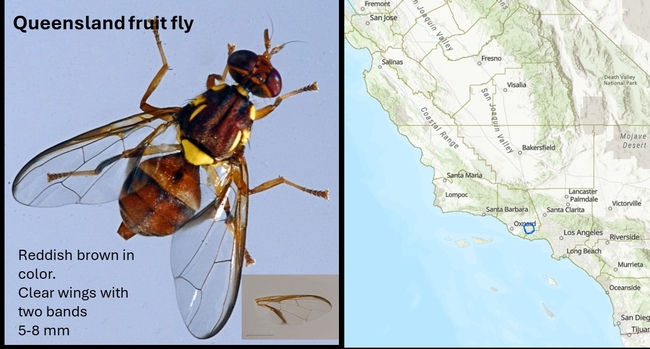Invasive Fruit Fly Quarantine
What to know as a SJV citrus grower?
Sandipa Gautam
Area Citrus IPM Advisor
UC Statewide IPM Program Operations
Several species of invasive fruit flies that belong to the family Tephritidae are considered serious pests of hundreds of agricultural crops including citrus. These flies lay eggs on or near the fruit surface, and when the maggots hatch, they bore into the fruit, making it unfit for human consumption and causing major losses to fruits and vegetable production. California is experiencing an unusually high number of invasive fruit fly detections in the 2023/24 season and several areas in California are now under a fruit fly quarantine. For many invasive fruit fly species, quarantine is triggered when two or more adult flies are caught in a trap or by a single detection of larvae or pupae indicating a breeding population. Core area is 0.5-mile radius around the detection site and a quarantine area is 4.5-mile radius around each detection.
Counties Currently Impacted by Invasive Fruit Fly Quarantines:
- Oriental fruit fly: Contra Costa, Riverside, Sacramento, San Bernardino, and Santa Clara Counties (Figure 1)
- Mediterranean fruit fly: Los Angeles County (Figure 2)
- Tau fruit fly: Los Angeles County (Figure 3)
- Queensland fruit fly: Los Angeles and Ventura Counties (Figure 4)
Why is fruit fly quarantine concerning to citrus growers?
Citrus is a known host to all invasive fruit fly species. Fruit fly life cycle begins as eggs laid by adult female on surface or under the fruit rind maggots hatch and bore into the fruit and develop inside the fruit (Figure 5). They drop to the ground and pupate. Many fruit fly species are known to overwinter as prepupae or pupae, but some species like Medfly can overwinter in all life stages inside fruit or as pupae on the ground. Adults emerge in early spring and the life cycle continues. Because eggs and immatures can be present inside the fruit, movement of infested fruit may accidentally transport them to a new area where fruit fly has not been detected.
Invasive fruit flies – what to look for?
Four species of fruit flies are currently regulated in California. The adults may look similar to houseflies but are distinctly different in color and the markings on the body. They are about 5-8 mm in size, much bigger than spotted wing drosophila, another invasive species that has been established in California.
- Oriental fruit fly: ~8 mm size, bright yellow colored body with a dark T shaped mark on the abdomen (Figure 1).
- Mediterranean fruit fly (Medfly): ~5-6 mm in size, yellow-light brown body, clear wings with brown bands (Figure 2)
- Tau fruit fly: ~7 mm in size, yellow body with black markings (Figure 3)
- Queensland fruit fly: ~5-8 mm in size, wasp-like body, reddish brown in color with distinct yellow markings, clear wings with band along the top margin.
Figure 1. Oriental fruit fly adult with identifying characters (left) and areas in California under quarantine as of January 2024: Contra Costa, Riverside, Sacramento, San Bernardino, and Santa Clara Counties (right).
Figure 2. Mediterranean fruit fly adult with identifying characters (left) and areas in California under quarantine as of January 2024 – Los Angeles County (right).
Figure 3. Tau fruit fly adult with identifying characters (left) and areas in California under quarantine as of January 2024: Los Angeles County (right).
Figure 4. Queensland fruit fly adult with identifying characters (left) and areas in California under quarantine as of January 2024: Ventura County (right).
You can find more information about invasive fruit fly species including interactive quarantine maps, regulatory information and pest profile information below: https://www.cdfa.ca.gov/plant/PDEP/treatment/index.html
Figure 5. Fruit fly larvae are white, legless maggots. They bore into the fruit and feed on pulp. Infested fruit may drop and decay.
What is happening to prevent fruit fly spread?
The California Department of Food and Agriculture (CDFA), in cooperation with the United States Department of Agriculture (USDA) and County Agricultural Commissioners, has initiated local regulatory measures to eradicate and prevent the statewide spread of Queensland fruit fly, Tau fruit fly, Mediterranean fruit fly and Oriental fruit fly. California Citrus Quality Council (CCQC) in coordination with researchers is developing a systems approach that allows for post-harvest treatment of citrus fruit for movement from the core to pack.
What can you do?
- If you are a grower inside the quarantine area, follow regulations about harvesting, processing, or storing fruit. Contact your County Ag Commissioner about the latest regulations, or review FAQs here: https://www.cdfa.ca.gov/plant/fruitfly/docs/Invasive_Fruit_Fly_FAQ_Industry_1-18-24.pdf . If your property is under fruit fly quarantine, follow either pre or postharvest treatment protocols from USDA to move fresh fruit
- Grower outside the quarantine area, stay informed, invest in trapping and pre-quarantine treatments to avoid potential harvest delays should a quarantine be established in the future. For information on prevention and exclusion visit: https://www.cdfa.ca.gov/plant/PE/InteriorExclusion/current_preharvest_treatment.html
- Quarantines boundaries can change rapidly, so it is critical to stay in communication with your local agricultural commissioner.
- Report any suspected invasive fruit fly sightings to CDFA, USDA or your local County Agricultural Commissioner.
- Encourage neighbors, friends, and family to avoid moving any homegrown produce from their properties and to cooperate with agriculture officials working in their area.
- Help spread the “Don't Pack a Pest” message to travelers or those receiving produce in the mail or through other shipping channels.
- Share social media posts created or shared by CDFA, USDA or County Agricultural Commissioners.




